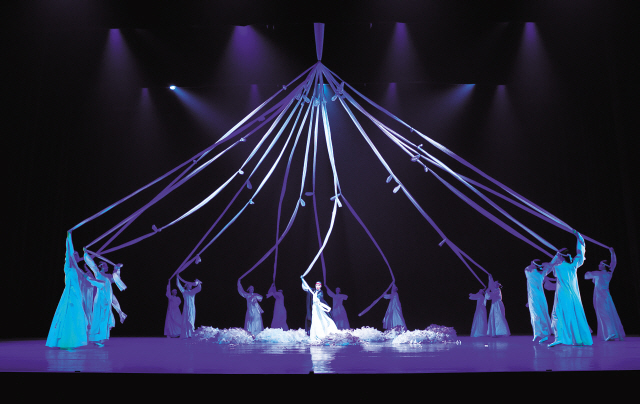Korea’s traditional dance troupe re-stages its 1984 original repertoire ‘Madam Domi’
There have been a lot of efforts by local ballet troupes to create and promote original performances, mostly based on Korea’s traditional folktales.
The Korean National Ballet’s “The Love of Chunhyang” and Universal Ballet Company’s “Shimchung” are some of the successful examples, blending ballet movements and Korea’s traditional sentiments.
Outside the ballet scene, however, developing original repertoire has been a challenge. It has been especially difficult for troupes that specialize in traditional Korean dance, mostly due to its lack of popularity among today’s dance fans.
There have been a lot of efforts by local ballet troupes to create and promote original performances, mostly based on Korea’s traditional folktales.
The Korean National Ballet’s “The Love of Chunhyang” and Universal Ballet Company’s “Shimchung” are some of the successful examples, blending ballet movements and Korea’s traditional sentiments.
Outside the ballet scene, however, developing original repertoire has been a challenge. It has been especially difficult for troupes that specialize in traditional Korean dance, mostly due to its lack of popularity among today’s dance fans.

Hence it is a pleasant surprise to hear the National Dance Company of Korea is re-staging its 1984 original repertoire, “Madam Domi,” almost 30 years after its first run in Los Angeles. The state-run dance troupe was formed in 1962 with the aim of creating new dances based solely on Korea’s traditional dance and performing the works at home and abroad. The company celebrates its 50th anniversary this year, and the restaging of “Madam Domi” is the first project to officially launch its staple repertoire ― which has been virtually non-existent until now.
A poignant love story based on a local folktale, the piece was choreographed by the troupe’s founding director Song Beom. It was first staged in Los Angeles in 1984 during the summer Olympic Games. The piece received enthusiastic reviews in the U.S. at the time, for its artistic representation of Korean shamanism and an engaging narrative. It has been performed some 200 times since its first run, but never developed into a signature piece.
The original tale from Korea’s ancient kingdom Baekje (B.C. 18-A.D. 660) tells the story of a diligent carpenter Domi and his beautiful and happily-married wife, Arang. The plot develops as cruel king Gaeru, after hearing about Arang’s beauty, forces her to leave Domi and be his concubine. When she refuses, the infuriated king decides to abuse his power to destroy Domi. Against all odds, however, Domi and Arang survive and meet a happy ending.
However, viewers of the dance piece will experience a dark and even spiritual version of the story. Cha Beom-seok, a celebrated playwright who wrote its initial script, turned the original story into a tragic melodrama full of “han”: The piece is filled with grief and sorrow, and injustice and suffering, as was unveiled on Thursday to the press.
Cha also incorporates Korea’s traditional shaman dances, exploring the themes of love and death. Some would be reminded of Kim Yong-geol’s modern ballet piece “Orpheus and Eurydice,” which also used Korea’s shamanic, traditional images of afterlife. In fact, Kim Mi-ae, who starred as Eurydice in the ballet piece, plays Arang in “Madam Domi.” Kim, who is the wife of choreographer Kim Yong-geol, also serves as principal dancer of the National Dance Company of Korea.
In the original tale, Arang is a wise young woman who uses clever tricks to escape dangerous situations. In the dance version, however, she is simply a tragic, innocent victim. The scene where she finally reunites with her husband, only to find out his eyes have been gorged out by the cruel king and he only has minutes to live, shows what the Korean concept of han is all about: the “feeling of unresolved resentment against injustices suffered, the sense of utter helplessness caused by the overwhelming odds, and the obstinate urge to take revenge,” as scholar Suh Nam-dong once described it. The sound of pansori, Korea’s traditional vocal and percussion music, is full of horror and resentment.
It should be also noted that Domi, who is a carpenter in the original tale, is now a musician who leads a troupe of dancers and singers instead; this intensifies the theatrical and musical experience of the piece, especially when the innocent man meets his tragic end.
One of the highlights of the show is certainly the last scene, which is a representation of Korea’s traditional, shamanic ritual performance, “gut.” Gut is the origin of Korean dance; it’s what produced the earliest forms of the dance some thousand years ago.
Choreographer Song chose to perform a famous gut developed and practiced in Jindo, South Jeolla Province. The particular ritual in the region is performed to release the “han” of the dead, and let him or her enter the afterlife without holding any grudges or laments.
The scene of the shamanic ritual, which also connotes reconciliation and forgiveness, is visually breathtaking. Most viewers won’t be able to experience anything like it again; the gut, performed as a group by female dancers donned in white hanbok, is engrossingly eerie while strikingly beautiful. Full of han and artistry, “Madam Domi” manages to show the origin of Korean dance, as well as its innermost spirit.
“Madam Domi” runs from Sept. 14 to 19 at the National Theater of Korea in Seoul. For tickets and information, call (02) 2280-4114.
By Claire Lee (dyc@heraldcorp.com)







![[From the Scene] Monks, Buddhists hail return of remains of Buddhas](http://res.heraldm.com/phpwas/restmb_idxmake.php?idx=644&simg=/content/image/2024/04/19/20240419050617_0.jpg&u=20240419175937)







![[From the Scene] Monks, Buddhists hail return of remains of Buddhas](http://res.heraldm.com/phpwas/restmb_idxmake.php?idx=652&simg=/content/image/2024/04/19/20240419050617_0.jpg&u=20240419175937)

![[KH Explains] Hyundai's full hybrid edge to pay off amid slow transition to pure EVs](http://res.heraldm.com/phpwas/restmb_idxmake.php?idx=652&simg=/content/image/2024/04/18/20240418050645_0.jpg&u=20240419100350)

![[Today’s K-pop] Illit drops debut single remix](http://res.heraldm.com/phpwas/restmb_idxmake.php?idx=642&simg=/content/image/2024/04/19/20240419050612_0.jpg&u=)